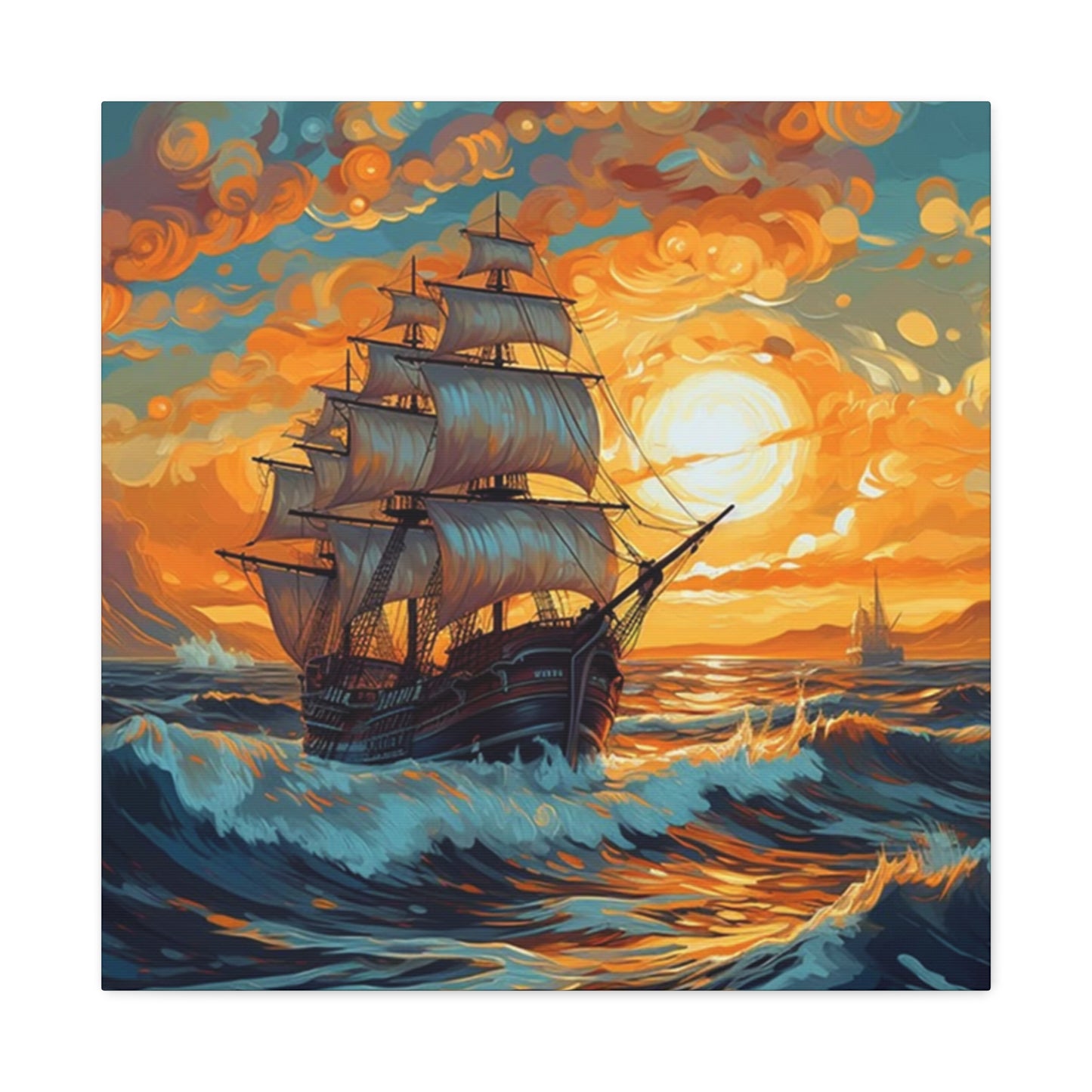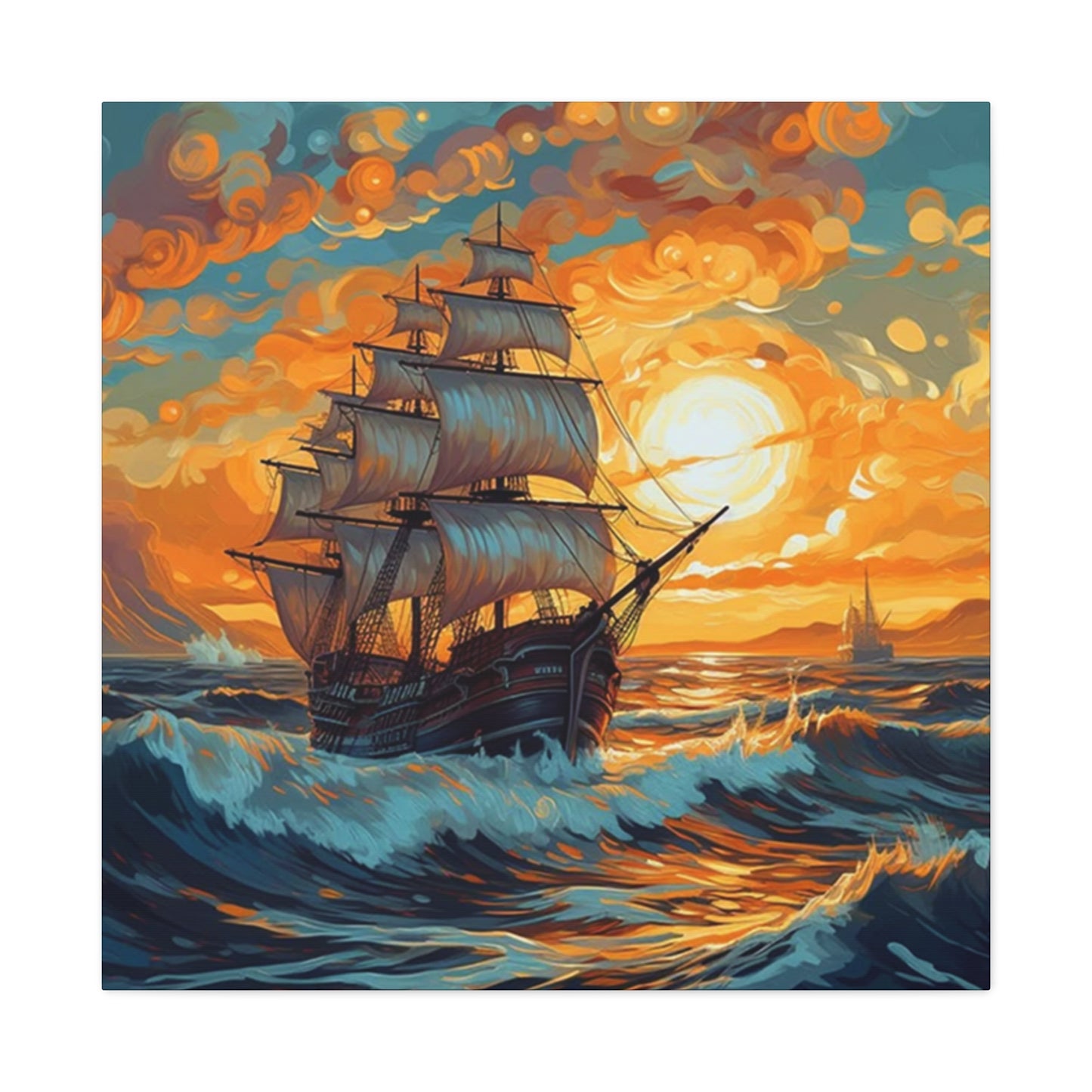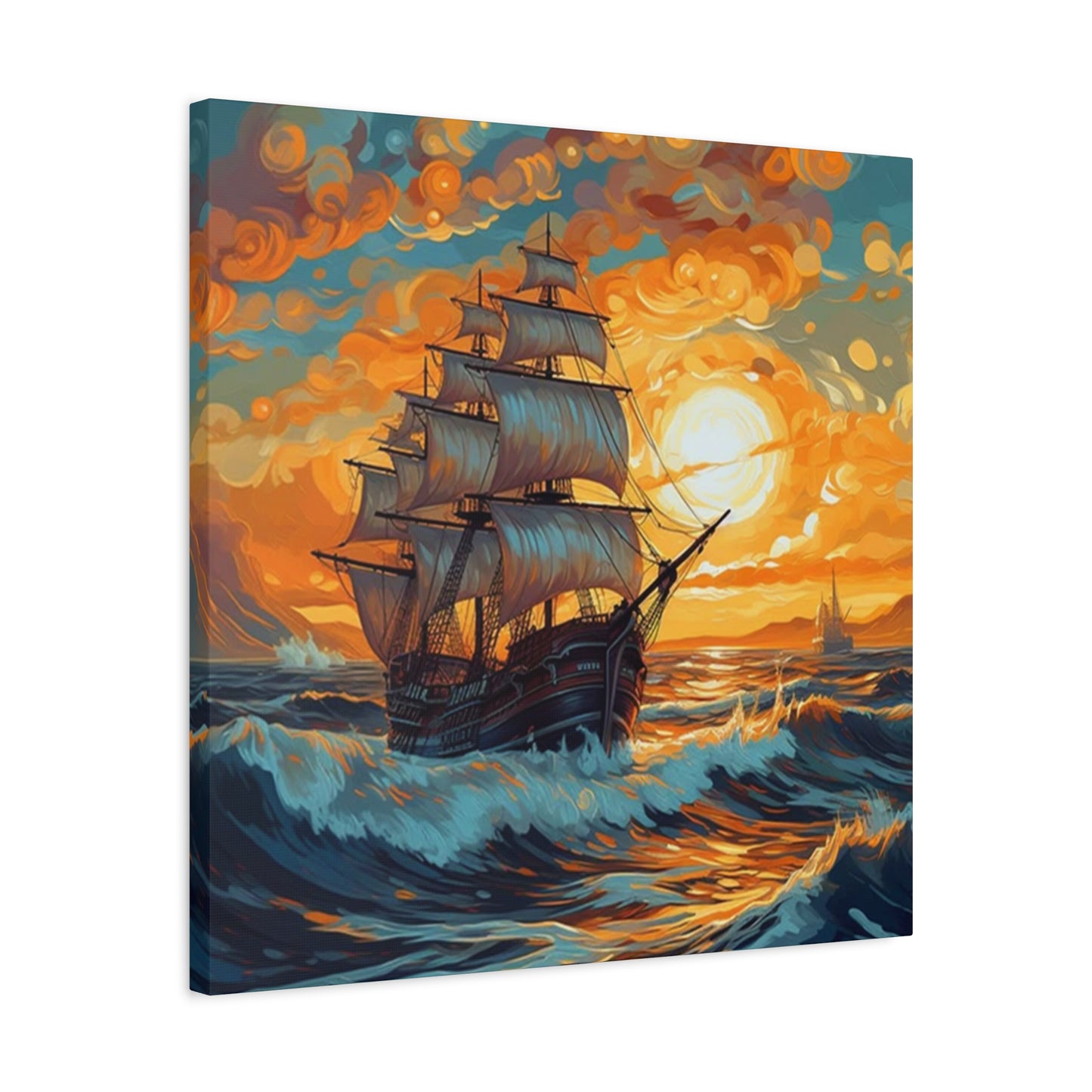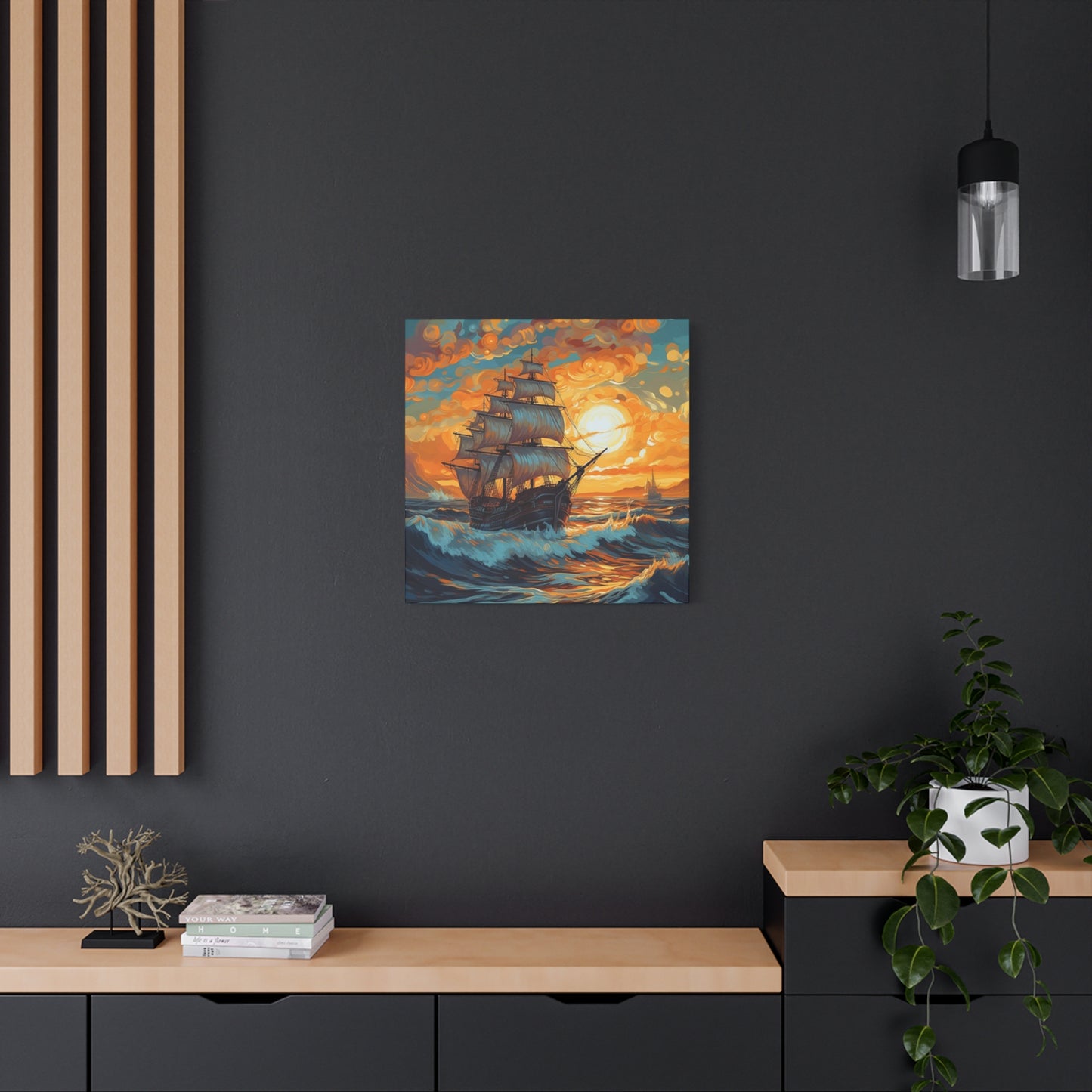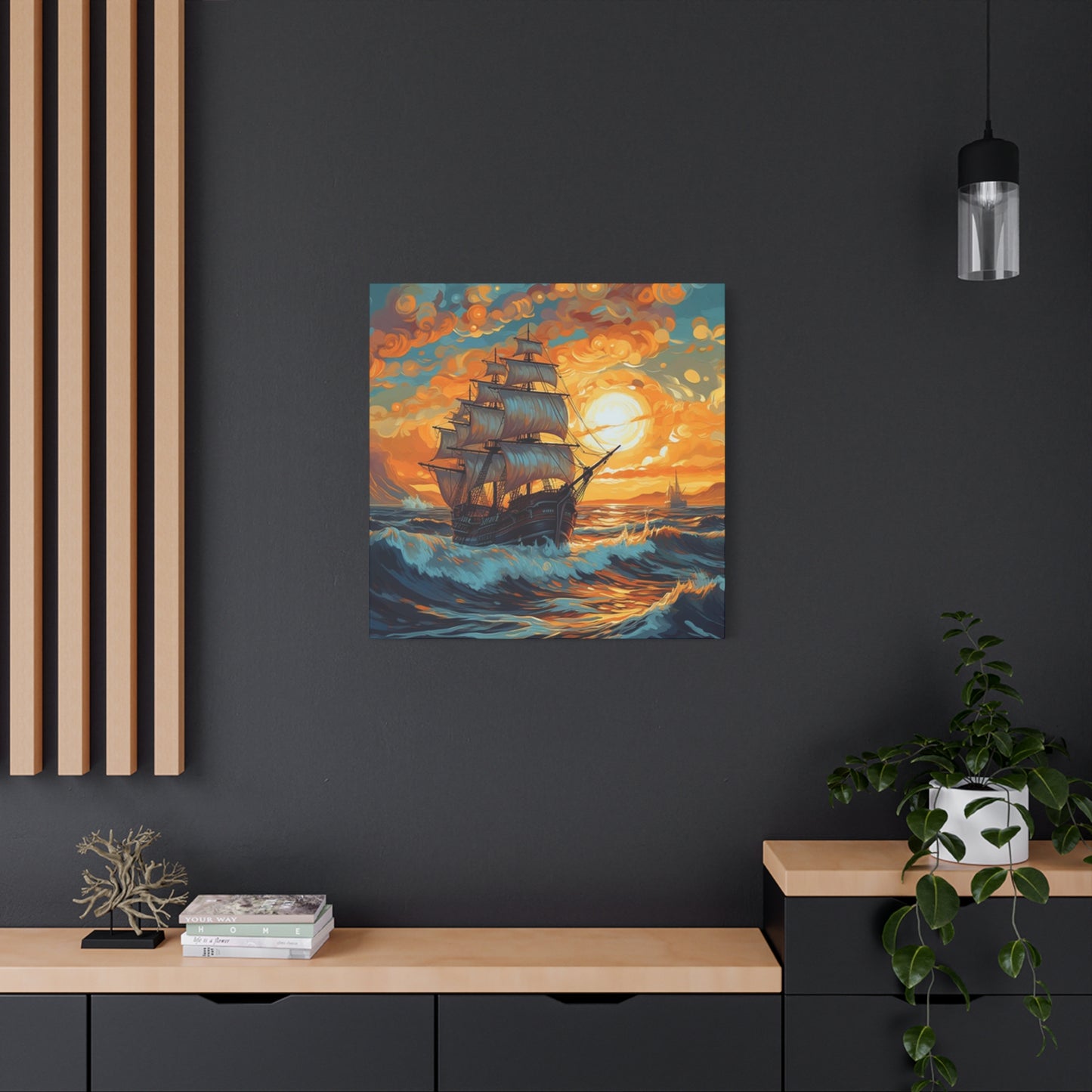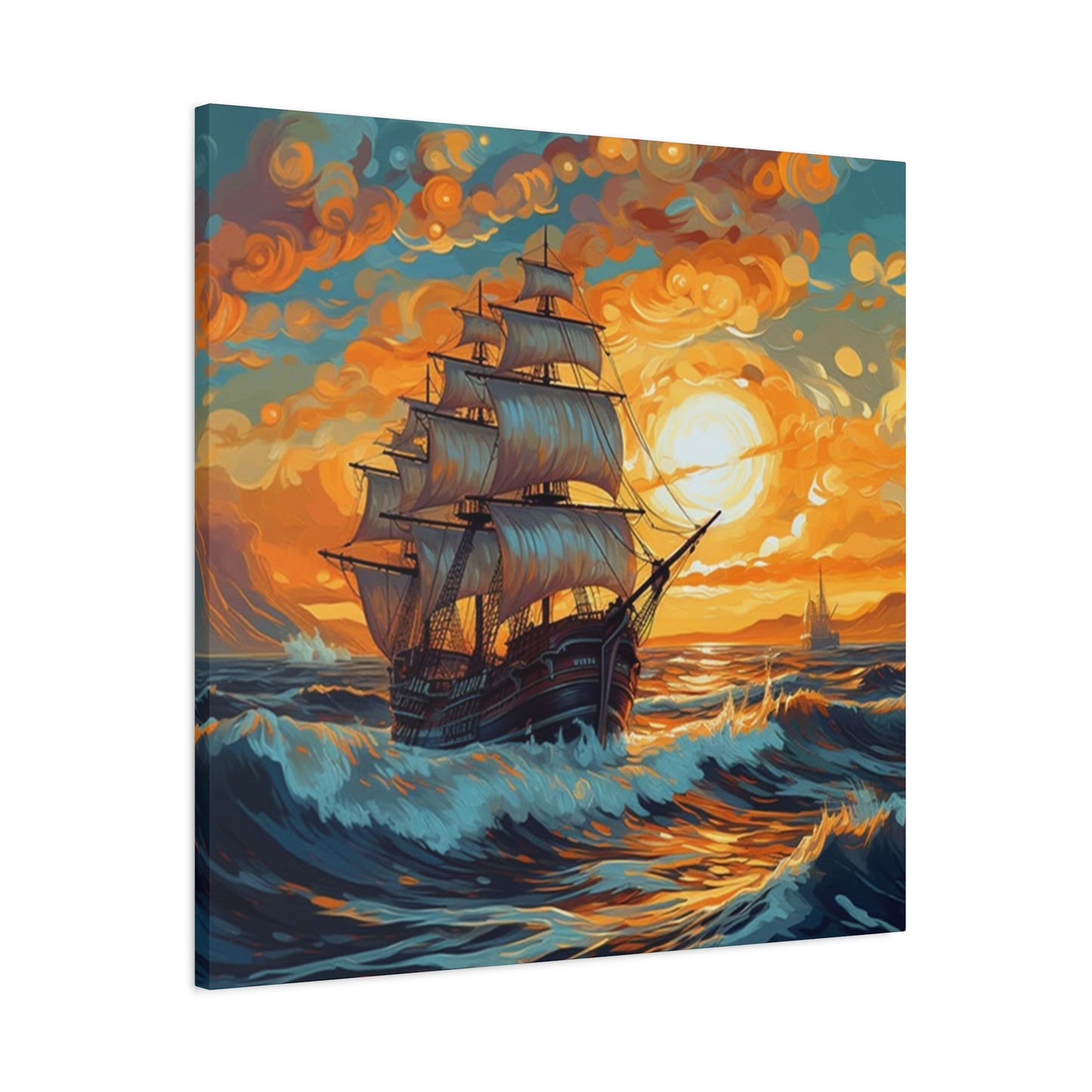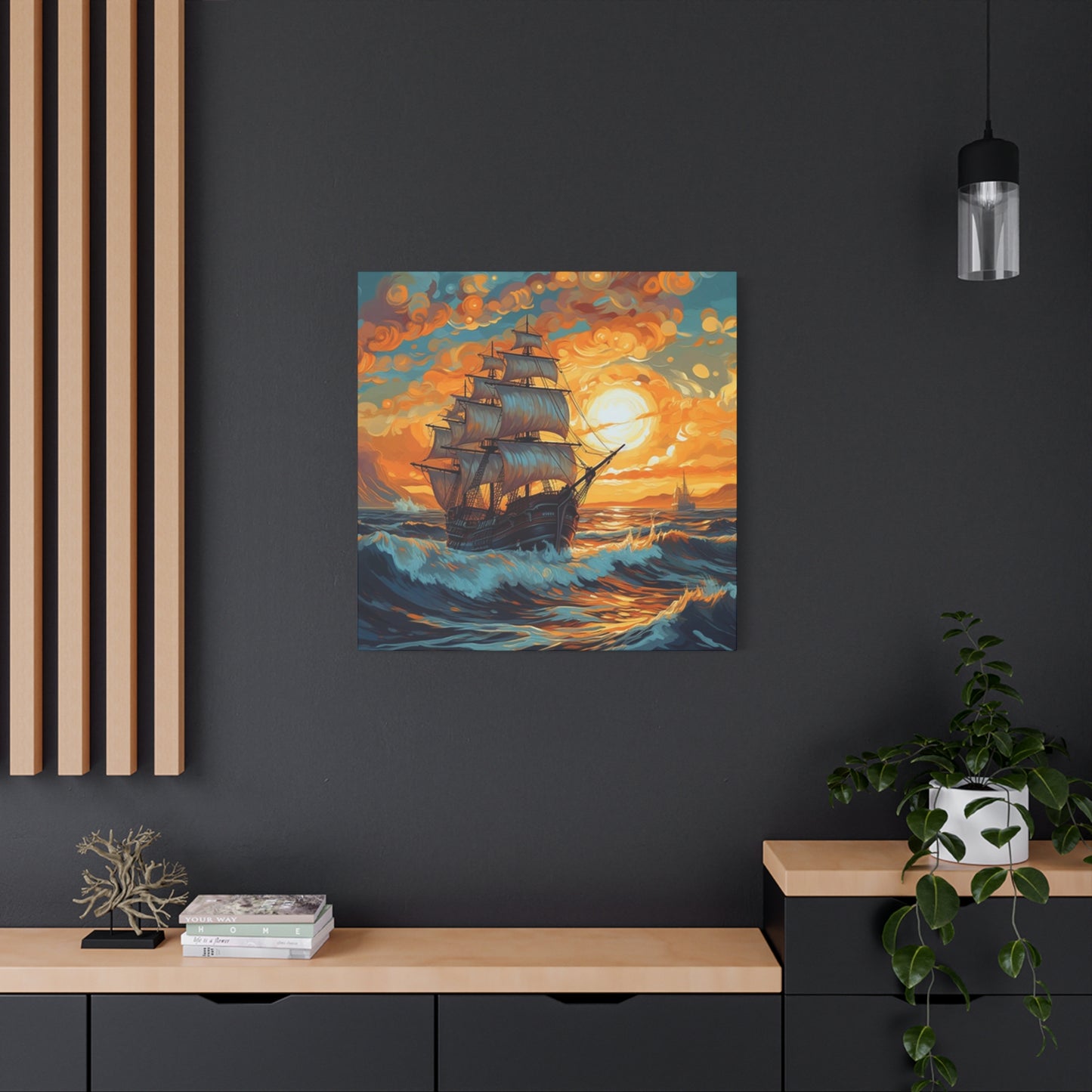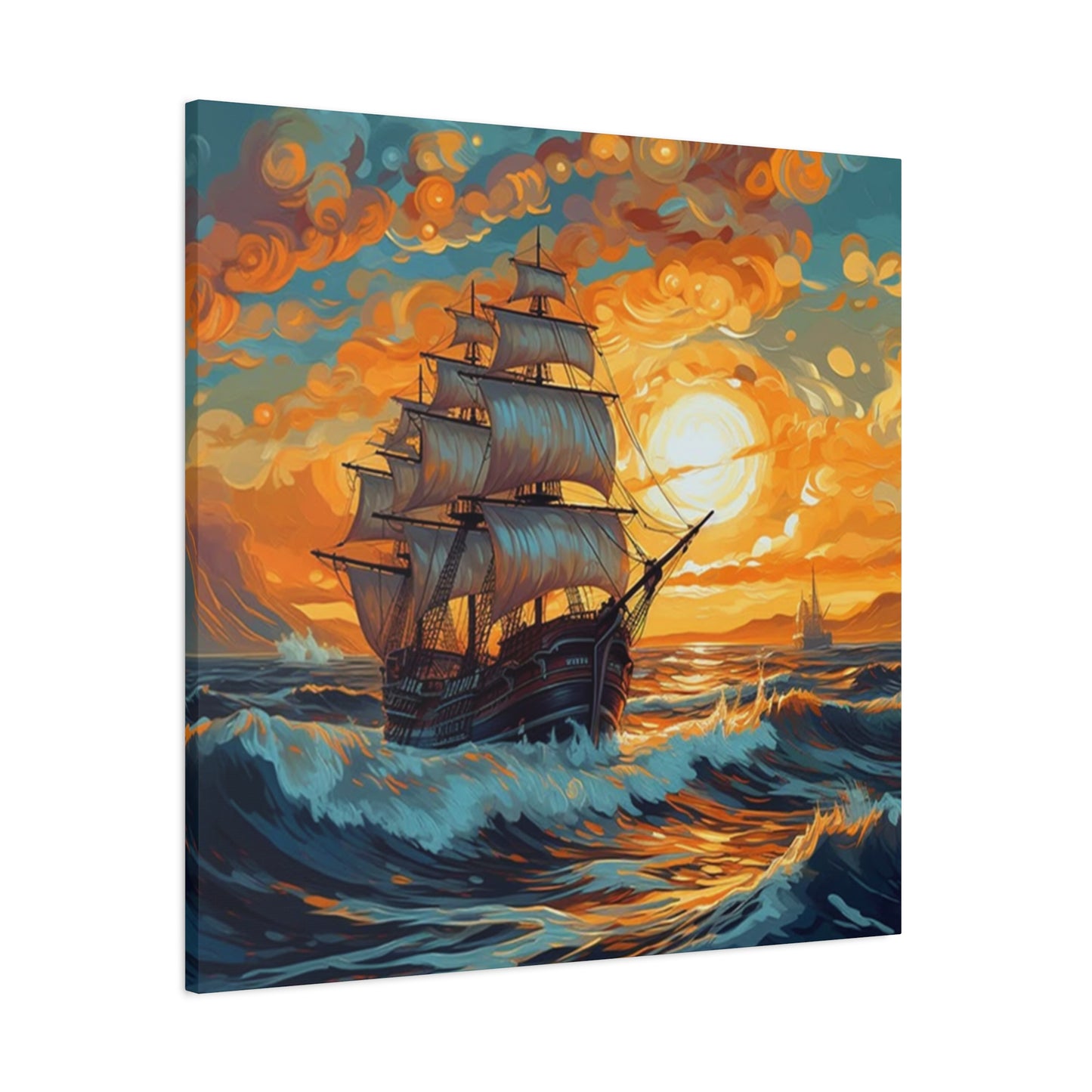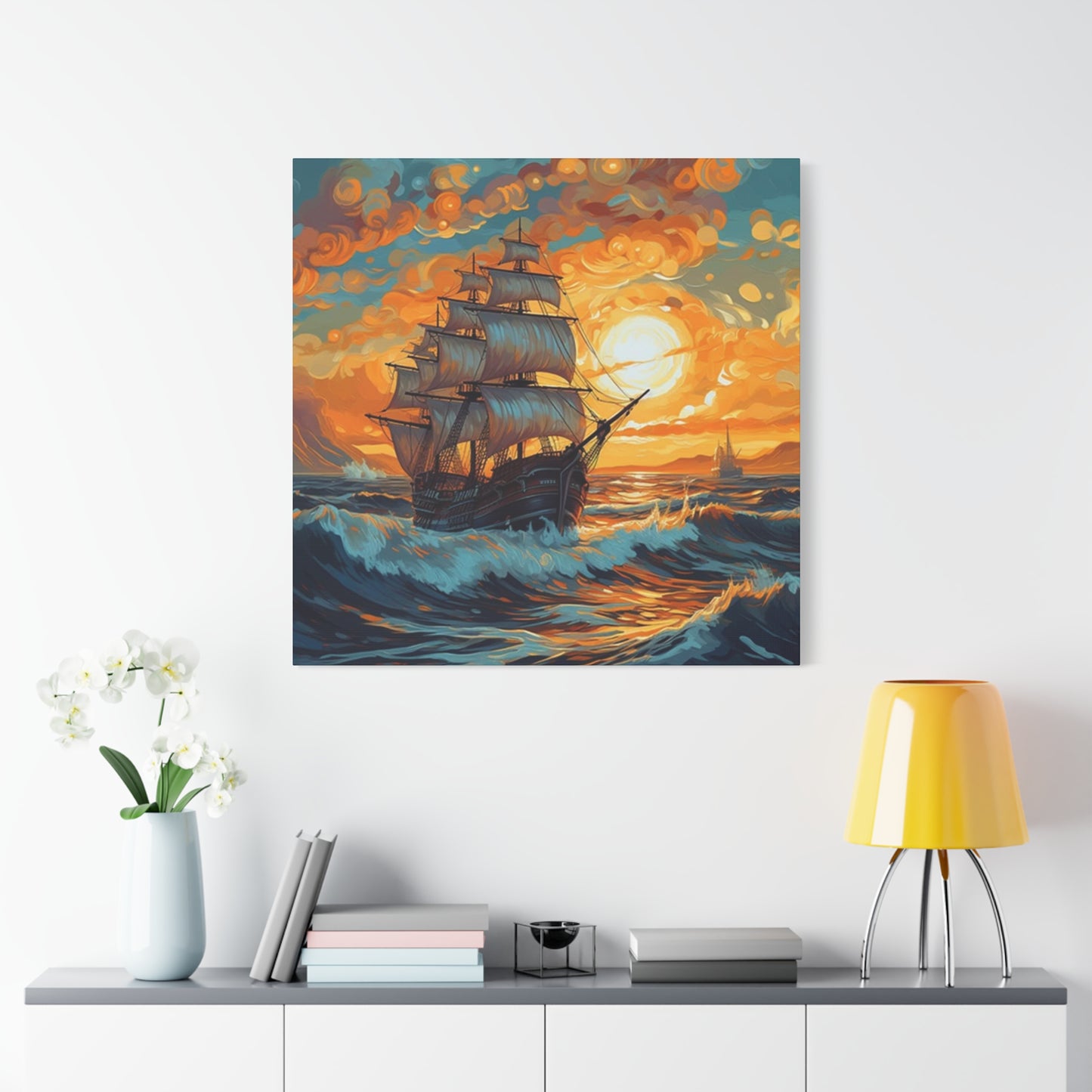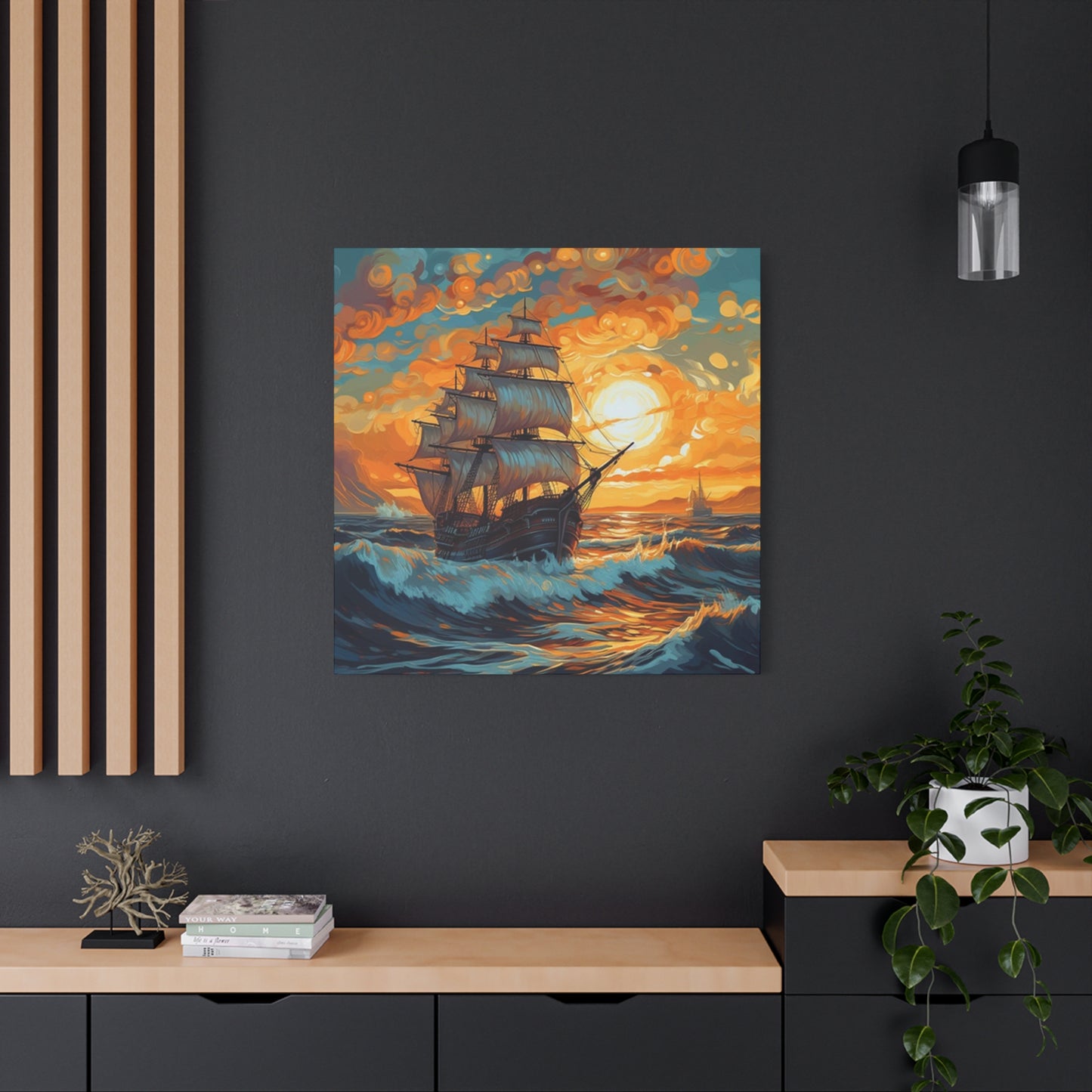The Golden Glow of Morning: Exploring the Symbolism Behind Ship Sailing During Dawn in Wall Art
The image of a vessel gliding through calm waters as the first rays of sunlight break across the horizon carries a profound emotional weight that transcends mere visual appeal. This timeless maritime scene has captivated artists, sailors, and dreamers throughout history, offering a window into moments of transition, hope, and boundless possibility. When incorporated thoughtfully into residential spaces, artwork featuring vessels at daybreak can transform ordinary rooms into sanctuaries of peace and contemplation.
The intersection of nautical imagery and the golden moments of early morning creates a unique aesthetic that speaks to something fundamental in human nature—our connection to the sea, our appreciation for natural beauty, and our innate desire for spaces that nurture our wellbeing. These carefully crafted pieces serve as more than decoration; they become portals to tranquil seascapes, reminding us of the vastness of the world beyond our walls and the endless opportunities that each new day presents.
In contemporary interior design, the challenge often lies in finding artwork that achieves multiple objectives simultaneously: creating visual interest, establishing emotional resonance, complementing existing design elements, and standing the test of changing trends. Maritime scenes captured during the early hours of daybreak excel in meeting all these criteria, offering versatility that few other artistic subjects can match. Whether your space reflects modern minimalism, coastal charm, traditional elegance, or eclectic fusion, these powerful images find their place with remarkable ease.
The growing appreciation for these particular artistic compositions stems from their ability to balance multiple design needs. They introduce color without overwhelming, suggest movement while maintaining serenity, and bring natural elements into spaces where direct connection to the outdoors may be limited. For urban dwellers especially, having a visual reminder of open waters and endless skies provides psychological benefits that extend far beyond aesthetic considerations.
As we explore the various dimensions of incorporating maritime artwork from the early hours into your living environment, we'll examine not just the practical aspects of selection and placement, but also the deeper connections these images forge with our emotional landscapes. From understanding the psychological impact of specific color palettes to discovering how these pieces can literally alter the energy of a room, this exploration will provide you with the knowledge to make informed, inspired choices for your space.
Warm Color Schemes That Deliver Interior Peace
The colors present in dawn maritime scenes—amber, gold, rose, coral, soft orange, and warm beige—form a palette that interior designers have long recognized as particularly effective for creating welcoming, comfortable spaces. These hues trigger psychological responses rooted in human evolutionary history, as warm tones signal safety, nourishment, and social connection. When incorporated through artwork featuring vessels at daybreak, these colors become integrated into your space in sophisticated ways that avoid the potential heaviness of painting entire walls in warm tones.
Color psychology offers fascinating insights into why these particular hues create such positive effects in residential environments. Warm tones stimulate the production of serotonin, a neurotransmitter associated with feelings of wellbeing and contentment. They're also associated with physical warmth, triggering responses that make spaces feel literally cozier, even when ambient temperature remains unchanged. This psychological warming effect makes rooms feel more inviting and comfortable, encouraging relaxation and social interaction.
The specific warm tones present in dawn scenes also avoid the potential pitfalls of more saturated warm colors. While bright reds and oranges can feel aggressive or overstimulating in large doses, the softer, more nuanced versions present in early morning light offer warmth without intensity. These subdued tones provide color impact without overwhelming, bringing life to neutral spaces without creating visual chaos or clashing with existing color schemes.
Integrating these warm tones through artwork rather than structural elements like wall color or large furniture pieces also offers flexibility and reversibility. Your color preferences and needs may shift over seasons or years, and having warm tones concentrated in changeable elements allows for evolution in your design scheme. During summer months, the warm tones of a dawn maritime scene might be balanced with cooler accessories and textiles. In winter, these same warm tones become more prominent when paired with warmer, richer surrounding elements.
The way these warm tones interact with different lighting conditions throughout the day adds another dimension to their value. In morning light, the warm tones of the artwork resonate with natural dawn light entering through windows, creating harmony between interior and exterior. During midday, when light becomes cooler and bluer, the warm tones of the artwork provide balance and counterpoint. In evening artificial light, particularly warm-toned LED or incandescent lighting, these colors come fully alive, glowing with rich depth that makes them particularly impactful during the hours you're most likely to be home and experiencing the space.
Maritime Scenery for Serene Living Spaces
The ancient human connection to the sea runs deep in our collective consciousness, manifesting in everything from our earliest mythologies to our contemporary vacation choices. Even for those who don't live near coastal areas or identify as maritime enthusiasts, ocean imagery carries powerful associations with freedom, adventure, mystery, and the sublime power of nature. When these oceanic elements are combined with the peaceful vessel presence and soft light of early morning, they create compositions uniquely suited to enhancing the serenity of interior environments.
The psychological concept of biophilia—the innate human tendency to seek connections with nature and other forms of life—helps explain why maritime scenes resonate so strongly in residential settings. In increasingly urbanized, digital-dominated lives, we're often starved for connection to natural environments and natural rhythms. Bringing representations of natural scenes into our living spaces helps satisfy this fundamental need, even when direct access to nature is limited by geography or lifestyle.
Ocean scenes specifically offer certain advantages over other natural landscape options. Unlike forests or mountains, which can sometimes feel dense or imposing in representation, ocean vistas provide openness and expansiveness that make rooms feel larger and more airy. The infinite quality of the sea horizon creates a visual release, a sense that space extends beyond the physical boundaries of walls. This perceived expansion of space contributes to feelings of freedom and possibility, countering the potential claustrophobia of enclosed environments.
The presence of a vessel within these ocean scenes adds human element and narrative possibility without overwhelming the natural serenity. A ship suggests human courage, ingenuity, and the desire to explore—admirable qualities that add inspirational dimension to decorative pieces. Yet when rendered as small or moderate elements within vast seascapes, vessels maintain appropriate scale, reminding us of our proper relationship to natural forces: significant but not dominant, capable but humble, present but respectful.
Affectionate Ocean Imagery for Interior Styling
The romance of the sea has inspired poets, musicians, and artists for millennia, capturing imaginations with its combination of beauty, power, mystery, and the adventurous spirit of those who navigate its waters. When we translate this romance into visual artwork for residential spaces, we tap into deep cultural narratives about courage, exploration, love, and the poignant beauty of departure and return. These themes, when expressed through carefully crafted maritime imagery, bring layers of meaning and emotional resonance that elevate spaces from merely attractive to truly moving.
Romance in this context encompasses multiple dimensions beyond simple sentimentality. There's the romance of adventure—the call to explore unknown territories and test oneself against challenges. There's the romance of solitude—finding peace and self-knowledge in the vast quiet of ocean expanses. There's the romance of craftsmanship—the beauty of well-designed vessels representing human ingenuity and skill. And yes, there's the romance of human connection—ships as vehicles for reunions, as symbols of loved ones who sail away and eventually return.
These multilayered romantic associations make maritime imagery particularly rich in symbolic potential. Unlike purely decorative subjects that exist solely for visual appeal, ships and seas carry stories, suggest narratives, and invite viewers to project their own meanings and memories onto the scenes. This narrative quality gives these pieces staying power; they don't become merely familiar with time but rather deepen, revealing new facets as our own life experiences evolve and our perspectives shift.
Dawn Vessel Imagery That Awakens the Traveling Spirit
Wanderlust—that deep, sometimes aching desire to explore distant places, experience different cultures, and expand one's understanding of the world through travel—is a powerful force in contemporary life. For many people, this desire goes unfulfilled for long stretches due to practical constraints of work, family responsibilities, financial limitations, or global circumstances. Artwork that captures the essence of journey and exploration provides a form of vicarious travel, keeping the spark of wanderlust alive during periods when actual travel isn't possible while also serving as inspiration and motivation for future adventures.
Ships at dawn carry particularly strong wanderlust associations because they capture vessels at the beginning of journeys, heading toward distant horizons with unknown adventures ahead. This departure moment, filled with anticipation and possibility, resonates strongly with the wanderlust spirit. Unlike images of ships in harbor or returning home, vessels heading outward into the open sea represent the brave choice to explore, to leave comfort behind in pursuit of experience and discovery.
The combination of dawn timing and outbound direction creates layered symbolism that operates on multiple levels. Dawn itself represents new beginnings, fresh starts, and the opportunity to approach life with renewed energy and perspective. The outbound journey represents willingness to step beyond the familiar, to embrace uncertainty, and to trust that the rewards of exploration justify its challenges. Together, these elements create powerful imagery that speaks directly to the hearts of those who feel called to explore.
For those unable to travel as much as they'd like, surrounding themselves with imagery that captures the essence of journey provides important psychological benefits. These pieces serve as reminders that the world remains vast and full of possibilities, that your current geographic location doesn't define the limits of your experience or imagination. They keep alive the sense of yourself as someone who explores, who seeks, who remains curious about what lies beyond the horizon, even when circumstances temporarily ground you.
Gentle Morning Illumination in Ocean Artwork
Light quality separates memorable artwork from forgettable pieces across all subjects and styles, but in maritime scenes, light becomes not merely an element but often the primary subject. The particular characteristics of morning illumination—soft, directional, warm, and gradually intensifying—create opportunities for visual effects that simply cannot be achieved in harsh midday conditions or artificial lighting scenarios. Artists who master the representation of this delicate light create pieces that glow with an inner luminosity that draws viewers in and holds their attention through subtlety rather than shock.
The technical challenge of depicting soft morning light requires understanding how light behaves when traveling through atmosphere at low angles, how it interacts with different surfaces and textures, and how our eyes and brains interpret these interactions. Skilled artists demonstrate their mastery through subtle gradations rather than stark contrasts, through implied light sources rather than obvious ones, through the way light influences color temperature across the composition rather than through simple light-and-dark relationships.
In maritime contexts, light behavior becomes even more complex due to the reflective properties of water. Water acts as both mirror and filter, bouncing light in multiple directions while also absorbing certain wavelengths. The result is a constant interplay between direct light, reflected light, and the natural color of water itself. When morning light enters this equation, adding its particular warmth and low angle, the complexity increases further, offering visual richness that rewards sustained viewing and contemplation.
The emotional impact of soft light representations cannot be overstated. Harsh, direct light creates drama and tension, useful in certain contexts but counterproductive when serenity is the goal. Soft, diffused morning light, by contrast, creates gentleness and approachability. It invites you into the scene rather than holding you at a distance. It suggests the beginning of possibility rather than the confrontation of reality. These emotional qualities make artwork featuring this light quality particularly suited to residential environments where comfort and peace are priorities.
Technical execution significantly affects how successfully artwork captures soft morning light. Careful attention to edge quality—where illuminated areas meet shadowed areas—prevents harsh transitions that would betray the soft quality of the light source. Subtle color shifts across the composition reflect how atmosphere affects light perception at different distances and angles. The handling of highlights, particularly on water surfaces, requires delicacy; too bright and they pierce the soft atmosphere, too dim and the sense of luminosity disappears.
Display Approaches for Sunrise Maritime Prints
The presentation of artwork significantly influences its impact and your ongoing enjoyment of it. While the image itself carries primary importance, the decisions you make about framing, matting, glazing, and mounting can dramatically affect how that image reads in your space, how well it's preserved over time, and how successfully it integrates with surrounding design elements. For prints featuring vessels at sunrise, these presentation choices can either enhance the warmth and serenity inherent in the imagery or inadvertently work against those qualities.
Frame selection provides your first major decision point in presentation strategy. Frame styles range from ornate traditional designs to sleek contemporary profiles, with countless variations in material, finish, and detail level. For sunrise maritime prints, frames that complement rather than compete with the artwork generally serve best. The warm tones in dawn scenes pair beautifully with natural wood frames in medium to warm finishes—oak, walnut, cherry, and similar woods that echo the golden qualities of sunrise light. Metal frames in brass, bronze, copper, or warm-toned gold create elegant presentations that honor the sophisticated nature of maritime subjects while maintaining contemporary sensibilities.
Frame proportions matter as much as style. Wider frames create substantial presence and work well for larger pieces or in rooms with bold design elements, preventing artwork from being visually overwhelmed by its surroundings. Narrower frames maintain focus on the image itself, allowing the artwork to breathe and creating cleaner, more modern presentations. For pieces featuring expansive seascapes, frames that don't compete for attention often serve best, keeping focus on the horizontal expanse of ocean and sky rather than drawing eyes to ornate borders.
Matting provides another crucial decision point with significant impact on presentation. White or off-white mats create clean, gallery-quality presentations that work across diverse interior styles. These neutral mats provide breathing room around the image while maintaining focus on the artwork itself. Colored mats offer opportunities to draw out specific tones from the image—a warm cream mat might echo the golden tones of sunrise, while a soft gray could complement cooler elements in the sky or water. Multiple mat layers add depth and sophistication, creating shadow lines and dimensional interest that elevate presentation quality.
The width of matting affects visual weight and the relationship between image and wall. Wider mats create more substantial presentations, making even modest-sized prints feel important and worthy of attention. They also provide practical benefits by increasing the distance between the image and the frame's edge, reducing the risk of moisture damage from condensation inside the glazing. Narrower mats maintain intimacy and work well in gallery wall arrangements where multiple pieces appear together and excessive matting would create visual competition between pieces.
Perfect Focal Point Art for Social Spaces
Living rooms function as the heart of many homes, serving as gathering places for family, entertainment venues for guests, and personal retreats for relaxation. Artwork in these multipurpose spaces must meet diverse criteria, creating visual interest that engages varied audiences while supporting the room's multiple functions. Large-scale maritime scenes featuring vessels at dawn excel in this role, offering sophistication that appeals to adults, beauty that welcomes guests, and serenity that supports relaxation after demanding days.
Statement artwork commands attention and establishes visual hierarchy within a space. In living rooms where multiple design elements compete for notice—furniture, textiles, architectural features, electronics, and decorative objects—a significant piece of artwork provides a clear focal point that anchors the space and guides design decisions. A substantial maritime dawn scene positioned prominently creates this anchoring effect, giving the eye a place to land and providing a reference point that unifies surrounding elements.
Scale represents the primary factor determining whether artwork functions as a statement piece. General design guidelines suggest artwork should occupy roughly two-thirds to three-quarters the width of furniture below it, such as sofas or console tables. However, these guidelines serve as starting points rather than rigid rules. In rooms with high ceilings or expansive walls, going larger creates appropriate impact and prevents artwork from appearing insignificant. In more intimate spaces, moderate sizing that allows breathing room around the piece often creates more comfortable, less overwhelming presentations.
The horizontal orientation typical of seascapes particularly suits living room applications. Most living room walls are wider than they are tall, and horizontal artwork complements these proportions naturally. The horizontal format also relates well to the primary furniture pieces in living rooms—sofas, console tables, and entertainment centers—which are predominantly horizontal. This shape harmony creates visual cohesion that feels intentional and sophisticated rather than accidental or awkward.
The specific imagery of dawn maritime scenes provides conversational interest that serves social functions well. Unlike abstract pieces that some guests may find difficult to engage with, or overly personal imagery that speaks primarily to the homeowner, maritime scenes offer universal accessibility combined with layers of potential interpretation. Guests can appreciate the technical skill in light rendering, relate to travel experiences or aspirations, discuss symbolic meanings, or simply enjoy the visual beauty, giving everyone entry points for engagement regardless of their art background or personal preferences.
Color palettes in dawn maritime scenes typically balance enough color to create interest and warmth without introducing problematic coordination challenges. The warm golds and ambers complement wood furniture tones naturally. The blues and teals of water and sky work with both warm and cool color schemes. The overall softness prevents the artwork from clashing with patterned textiles or competing with other colorful elements. This chromatic flexibility makes maritime dawn scenes particularly forgiving choices, working across diverse design schemes without requiring extensive renovation or redecoration.
The mood created by peaceful maritime imagery supports diverse living room activities effectively. During entertaining, the serene atmosphere provides visual interest without overstimulation, keeping focus on social interaction rather than environment. During family time, the calming qualities reduce tension and promote relaxation. During solo downtime, the contemplative nature of the imagery supports activities like reading, listening to music, or simply resting. This versatility across different use cases makes maritime artwork particularly valuable in multifunctional spaces.
Ocean Views for Peaceful Room Atmosphere
Atmosphere—that intangible quality that makes spaces feel particular ways—results from the careful orchestration of multiple elements working in concert. Light, color, texture, proportion, and imagery all contribute to the overall feeling a room evokes. When the goal is tranquility, maritime artwork featuring dawn scenes provides powerful atmospheric contributions, transforming spaces from merely quiet into truly peaceful. Understanding how these pieces create and support tranquil atmospheres allows for more intentional use in residential design.
The concept of tranquility encompasses several related but distinct qualities. There's physical calm—the absence of visual chaos or jarring elements that cause stress responses. There's emotional serenity—the feeling of peace that comes from being in spaces that nurture rather than agitate. There's mental quiet—the reduction of mental activity and worry that certain environments facilitate. Maritime dawn scenes address all these dimensions simultaneously, making them remarkably effective tools for creating comprehensively tranquil spaces.
The visual qualities that support tranquility are well-documented in environmental psychology research. Horizontal lines suggest rest and stability. Curved, flowing forms reduce tension more effectively than angular, sharp forms. Symmetry creates satisfaction and calm. Natural imagery triggers parasympathetic nervous system activation associated with relaxation. Soft color transitions feel more restful than stark contrasts. Maritime dawn scenes incorporate all these qualities, creating images that function as tranquility generators regardless of their specific subject matter details.
The absence of human figures in most maritime scenes contributes significantly to their tranquil quality. While human presence in artwork can create connection and narrative interest, it can also introduce tension, questions, or social awareness that works against deep tranquility. A vessel without visible crew suggests journey and presence without introducing interpersonal dynamics or human drama. This allows viewers to project themselves into the scene without encountering other personalities or narratives that might create complexity or conflict.
Sound associations also influence how maritime imagery affects room atmosphere. While artwork is silent, our brains supply associated sounds based on visual information. Looking at calm ocean scenes, we unconsciously recall or imagine the gentle sound of water lapping against hulls, the distant cry of seabirds, or the peaceful silence of early morning before the world awakens. These imagined soundscapes contribute to the overall tranquil effect, creating multi-sensory experiences from purely visual stimuli.
The psychological concept of attention restoration theory helps explain why natural scenes, including maritime views, create such effective tranquil atmospheres. According to this theory, modern life demands constant directed attention that depletes our cognitive resources and creates mental fatigue. Natural scenes allow for different types of attention—softer, less demanding, more restorative—that help replenish these depleted resources. Even representations of nature, including maritime artwork, provide these restorative effects, creating spaces that literally restore mental energy and reduce cognitive fatigue.
The implementation of maritime artwork for tranquil atmospheres requires attention to surrounding elements. Cluttered spaces negate the calming effects of even the most serene artwork, as visual chaos overwhelms the peaceful messaging of individual elements. Simplified surroundings that echo the openness and clarity of maritime scenes amplify tranquil effects. This doesn't require minimalism necessarily, but rather intentional curation that ensures every element contributes to rather than detracts from the overall atmospheric goal.
Color schemes surrounding maritime artwork significantly affect how successfully it creates tranquility. Warm neutrals support the warm tones of dawn scenes while maintaining overall visual softness. Cool grays and blues extend the water and sky tones, creating cohesive color stories that feel intentional and harmonious. High-contrast color combinations or multiple competing bright colors introduce energy and stimulation that may work against tranquility goals. When designing for maximum tranquility, color restraint serves you well.
Texture choices also contribute to or detract from tranquil atmospheres. Soft, natural textures—linen, cotton, wool, natural wood, stone—create tactile experiences that support visual tranquility. Rough, industrial, or highly processed materials introduce different aesthetics that may conflict with the natural serenity of maritime scenes. Layering various soft textures creates visual and tactile richness without sacrificing peacefulness, allowing for interesting, sophisticated spaces that remain fundamentally calm.
Furniture arrangement affects how effectively artwork contributes to tranquil atmosphere. Positioning seating to face maritime artwork allows for easy contemplation and ensures the piece serves its atmospheric function for those spending time in the space. Conversely, hanging significant tranquil artwork where it's rarely directly viewed—behind seating or in peripheral vision only—wastes its potential impact. The arrangement should facilitate both active appreciation during moments of intentional viewing and passive atmospheric contribution during other activities.
Lighting management becomes crucial for maintaining tranquil atmospheres throughout different times of day. Harsh overhead lighting undermines serenity regardless of artwork choices. Layered lighting using multiple softer sources creates gentle illumination that supports tranquility. Dimmer controls allow adjustment based on time of day, activity, and mood. Warm-toned bulbs complement the warm color palettes of dawn scenes while creating inherently more relaxing lighting than cool-toned alternatives. Thoughtful lighting transforms spaces from rooms with tranquil artwork into comprehensively tranquil environments.
The Meaning Behind Fresh Starts at Early Light
Symbolism adds depth and personal meaning to artwork, transforming decorative objects into carriers of significance that resonate with our values, aspirations, and life philosophies. Dawn has served as a powerful symbol across cultures and centuries, representing concepts that speak to fundamental human experiences and desires. When combined with the maritime journey symbol, dawn scenes create layered meanings that can profoundly affect how we relate to these images and the spaces they inhabit.
The most immediate symbolic meaning of dawn is new beginnings. Each sunrise marks the start of a fresh day, an opportunity to approach life differently, to leave behind yesterday's challenges or failures, and to embrace new possibilities. This daily renewal reminds us that we're not imprisoned by past mistakes or limited by current circumstances—change remains always possible, new paths always available. For those navigating life transitions, seeking personal growth, or working toward significant goals, this symbolism provides daily encouragement and inspiration.
Dawn also symbolizes hope and optimism. The darkness of night gives way to light, representing the triumph of hope over despair, light over darkness, good over evil in countless cultural narratives. This archetypal symbolism operates on deep psychological levels, tapping into fundamental human associations that transcend specific cultural or individual backgrounds. A dawn scene in your space functions as a constant reminder to maintain hopeful perspectives, to believe in positive possibilities, and to trust that difficult times eventually give way to better circumstances.
The transition quality of dawn carries its own symbolic weight. This is the liminal time between states, when day and night exist simultaneously. Such threshold moments represent transformation and the potential for moving from one state of being to another. For individuals in transitional life phases—between jobs, between relationships, between life chapters—dawn imagery validates the in-between experience while pointing toward the fully emerged new day ahead. It acknowledges transition as a legitimate and temporary state rather than failure to have arrived.
Ships themselves carry rich symbolic meaning throughout human cultures. They represent vehicles for journey, both physical and metaphorical. They symbolize courage—the willingness to leave safety and venture into uncertain waters. They suggest exploration, curiosity, and the human drive to discover what lies beyond known territories. They also represent vehicles carrying us toward destinations, suggesting purposeful movement rather than aimless drifting. The ship becomes a symbol of the self, navigating through life's waters, making passage through both calm and turbulent conditions toward distant goals.
The combination of dawn and ship creates particularly powerful symbolic synthesis. A ship at dawn represents the beginning of journey, the launching of endeavors, the courageous step into new territory undertaken with fresh energy and renewed commitment. This imagery speaks to starting new projects, relationships, or life chapters with optimism and determination. It symbolizes the brave choice to sail toward uncertain horizons despite not knowing exactly what you'll find, trusting in your capacity to navigate whatever conditions arise.
The calm waters typical in dawn maritime scenes add another symbolic layer—suggesting that new beginnings, while still uncertain, can be approached from places of inner calm rather than only anxiety or fear. The peaceful dawn departure contrasts with dramatic storm-tossed journeys, offering a different narrative about life change. This version suggests that major life moves can happen peacefully, that transformation doesn't require crisis, and that new chapters can begin from groundedness rather than only from dramatic disruption.
The horizon line present in virtually all maritime scenes carries its own symbolic significance. Horizons represent the limits of current vision, the edge of the known, and the boundary between here and there. They symbolize goals and destinations visible but not yet reached, requiring journey to achieve. The horizon constantly recedes as you approach it, suggesting that growth and exploration are ongoing rather than completed, that there are always new horizons beyond current ones. This can represent either frustration at never arriving or excitement about endless possibility, depending on perspective.
Light itself functions as central symbol in dawn imagery. Light universally represents knowledge, awareness, clarity, and consciousness across cultures. The growing light of dawn symbolizes increasing understanding, emerging clarity, and awakening to truth or reality. For those on paths of personal development, spiritual growth, or learning, this symbolism connects deeply with their lived experience of gradually seeing more clearly, understanding more fully, and awakening to aspects of themselves or reality previously hidden in darkness.
Seaside Style Elevated with Ocean Vessel Imagery
Coastal design aesthetics have maintained popularity for decades, appealing to those who love beach environments regardless of their actual proximity to coastlines. This enduring style encompasses various interpretations, from casual beach cottage approaches to sophisticated seaside elegance. Maritime artwork featuring dawn scenes functions beautifully across this spectrum, providing authentic nautical elements that ground coastal design choices in genuine maritime tradition rather than surface-level beach theming.
Traditional coastal design often emphasizes light, airy color palettes dominated by whites, sandy beiges, and various blues suggesting water and sky. Maritime dawn artwork introduces warmth into these cooler palettes without abandoning the coastal identity. The golden and amber tones of sunrise complement sandy beiges naturally while adding richness that prevents spaces from feeling washed out or sterile. This warm injection creates coastal spaces with personality and depth, moving beyond the sometimes generic feel of overly safe coastal color schemes.
Texture plays crucial roles in coastal design, with natural materials like weathered wood, woven fibers, natural linen, and organic elements creating tactile interest that prevents the light color palettes from feeling flat. Maritime artwork adds visual texture through the rendered surfaces of water, the dimensionality of vessels, and the atmospheric qualities of sky and light. When properly framed—perhaps in weathered wood or natural frames that echo coastal textures—these pieces contribute to the overall textural story while providing the visual interest that every space requires.
Authentic coastal design distinguishes itself from cliché beach theming through restraint and sophistication. Rather than filling spaces with starfish, seashells, and obvious beach motifs, sophisticated coastal design suggests maritime connections through more subtle, refined elements. High-quality maritime artwork provides this refined nautical presence, offering genuine connection to maritime tradition and seafaring history rather than vacation souvenir aesthetics. A beautiful rendering of a ship at dawn carries more design weight and sophistication than collections of decorative shells or fishing net displays.
The maritime history and heritage element of coastal design finds perfect expression in carefully chosen ship artwork. Sailing vessels, in particular, connect to the rich history of maritime exploration, trade, and the communities built around seafaring activities. Even for those without personal maritime history, these images connect to broader cultural heritage and the role that sea navigation has played in human civilization. This historical dimension adds depth and legitimacy to coastal design approaches, grounding them in something substantial rather than merely trendy.
Color balance in coastal spaces benefits from the specific palette present in dawn maritime scenes. Pure white and bright blues can feel cold or institutional in large doses, requiring warm tones to create comfort and livability. However, introducing warm tones through furniture or textiles sometimes conflicts with the cool coastal palette. Maritime dawn artwork introduces warmth through imagery rather than furnishings, allowing you to maintain cool furniture and textile choices while still achieving warmth and visual balance. The warmth exists in the art rather than competing with your coastal color commitments elsewhere.
Scale and proportion in coastal spaces often favor lighter, less substantial furniture to maintain airy feelings appropriate to beach environments. This relative lightness in furniture means wall space requires particular attention—empty walls in light-colored rooms can feel unfinished or institutional. Substantial maritime artwork provides necessary visual weight that grounds spaces without relying on heavy furniture. A significant dawn ship scene becomes the visual anchor that prevents the space from feeling too lightweight or insubstantial despite the appropriately airy furniture choices.
The adaptability of maritime themes across coastal sub-styles makes this artwork particularly valuable. In casual coastal cottages, these pieces provide sophistication that elevates the space beyond pure casual. In more formal coastal homes, they provide authentic nautical elements that prevent the space from feeling generic or disconnected from its coastal identity. In modern coastal interpretations emphasizing clean lines and contemporary sensibilities, maritime artwork provides organic, natural elements that soften the potential starkness of modern aesthetics while maintaining the sophisticated simplicity that characterizes this style.
Layering artwork into coastal spaces requires considering sight lines and relationships between pieces. Many coastal rooms feature collections of maritime elements—model ships, vintage oars, navigation instruments, or coastal photography. These collections should feel intentional rather than cluttered, and artwork selection must account for these supporting elements. A significant maritime dawn piece might serve as the focal point around which smaller elements are arranged, creating hierarchy that prevents visual competition. Alternatively, several smaller maritime pieces might create a gallery wall that tells a cohesive story about maritime life and ocean beauty.
Radiant Warmth from Optimal Light Moments
The golden hour—that magical period shortly after sunrise and before sunset—has captivated photographers and artists for generations with its extraordinary light quality. During these times, sunlight takes on characteristics that simply don't exist during midday hours, creating opportunities for capturing beauty that feels almost otherworldly. Understanding what makes this light so special helps explain why artwork featuring these conditions creates such powerful effects in interior spaces and why investing in pieces that successfully capture golden hour qualities delivers lasting satisfaction.
The physics behind golden hour light explains its unique characteristics. When the sun sits near the horizon, its light travels through significantly more atmosphere than when overhead. This extended journey through air molecules, water vapor, and particulate matter filters out shorter blue wavelengths while allowing longer red, orange, and yellow wavelengths to pass through. The result is the warm, glowing quality that makes everything touched by this light appear more beautiful, more romantic, and more visually appealing than in neutral midday illumination.
This warm color temperature triggers specific psychological and physiological responses in humans. Warm light is inherently less stimulating than cool light, making it naturally calming and comfortable. It's associated with fire, hearth, home, and safety throughout human evolutionary history. Our circadian rhythms respond to warm morning light as a gentle wake-up signal rather than an alarm, and to warm evening light as preparation for rest. When we bring images lit by this quality of light into our homes, we're introducing these biologically meaningful signals that support our natural rhythms and psychological needs.
The directional nature of golden hour light creates modeling and dimensionality that reveals form, texture, and structure in ways that overhead lighting cannot. When light strikes subjects from low angles, it creates longer shadows, highlights texture, and emphasizes three-dimensional qualities. In maritime scenes, this means water texture becomes visible and beautiful, vessel structures are revealed through shadow and highlight, and atmospheric elements like mist or clouds gain dimension and depth. This enhanced dimensionality makes images more engaging and visually complex, rewarding sustained viewing with details that aren't immediately obvious.
The intensity of golden hour light is gentler than midday sun, creating opportunities for viewing detail across the entire tonal range without blown-out highlights or impenetrable shadows. This extended tonal range means artists can include subtle gradations and nuanced color shifts that would be impossible in harsher light. For viewers, this means discovering new details and relationships with repeated viewing, as the careful rendering reveals itself gradually rather than all at once. This quality keeps artwork interesting over time, preventing the boredom that can result from images that reveal everything immediately.
The atmospheric conditions during golden hours enhance the light's magical quality. Morning often brings mist, fog, or haze that diffuses and scatters light, creating ethereal effects and soft transitions between illuminated and shadowed areas. These conditions reduce contrast while maintaining warmth, creating images that feel dreamlike without losing definition. This combination of softness and structure, mystery and clarity, creates visual paradoxes that hold attention and fascinate viewers, providing the visual interest that makes artwork worth living with long-term.
Color saturation behaves differently in golden hour light, with certain hues becoming more vivid while others recede. Warm tones—reds, oranges, yellows, and browns—intensify and glow, while cool tones become more subtle. This natural color enhancement means maritime dawn scenes featuring golden hour light include already optimized color relationships that require no artificial enhancement. The colors are naturally beautiful, naturally balanced, and naturally suited to creating visual harmony in residential environments.
The ephemeral nature of golden hour conditions adds to their appeal. These light qualities exist for limited times, creating urgency and preciousness around capturing them. When artists successfully capture these fleeting conditions, they're preserving something rare and temporary, making artwork featuring golden hour light feel like captured treasures. This preservation of ephemeral beauty gives these pieces a quality of miracle—they hold something that exists briefly and changes constantly, freezing it for permanent appreciation.
Final thoughts
Ship sailing at dawn wall art holds a timeless allure, blending natural beauty with powerful symbolism. The golden glow of morning has always represented new beginnings, hope, and the quiet strength of embarking on a journey. When captured through the imagery of a ship cutting through calm waters as the first light spills across the horizon, the result is more than just a beautiful piece of décor—it becomes a visual metaphor for courage, opportunity, and forward movement in life.
What makes this imagery so captivating is its universal appeal. The ship represents adventure, exploration, and resilience, while the rising sun embodies renewal, clarity, and optimism. Together, they create a narrative that resonates deeply with anyone standing at the threshold of change or growth. Whether displayed in a living room, office, study, or hallway, this kind of wall art can inspire daily reflection, encouraging viewers to embrace new paths with confidence and hope.
The warm tones of dawn—soft golds, gentle oranges, and muted pinks—also contribute to the calming yet energizing effect of the artwork. These hues naturally brighten a space, adding a welcoming glow that feels both serene and uplifting. Unlike darker maritime scenes, dawn imagery invites light and warmth, making it ideal for spaces where you want to cultivate a peaceful, optimistic atmosphere.
Another compelling aspect of ship-at-dawn wall art is its versatility in style. A realistic, finely detailed painting can evoke a sense of nostalgia and classic maritime beauty, perfect for traditional interiors or coastal-themed spaces. On the other hand, abstract or minimalist interpretations can blend effortlessly into modern or contemporary homes, where the focus is on mood and emotion rather than intricate details. Large panoramic prints can serve as stunning focal points, while smaller framed pieces can bring subtle elegance to corners and corridors.
Beyond its aesthetic value, this imagery carries a deeper meaning. A ship at dawn can symbolize personal transformation—venturing into the unknown, taking bold steps toward the future, or simply embracing a fresh start. It’s a reminder that every day brings new light and new opportunities. For many, this makes the artwork not just decorative but deeply personal, reflecting inner aspirations and journeys.
In the end, ship sailing during dawn wall art is a beautiful fusion of artistry and symbolism. It captures the poetic moment where night turns to day, stillness meets movement, and possibility awakens. Whether used to elevate a space aesthetically or to inspire a daily mindset of hope and exploration, these artworks bring more than beauty to a wall—they bring meaning. By incorporating this imagery into your décor, you create a space that feels timeless, inspiring, and warmly illuminated by the golden glow of new beginnings.

















